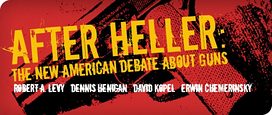Dennis Henigan begins his latest post by claiming that I endorse this non-sequitur: “Since there are liberal law professors who agree with Justice Scalia’s view of the Second Amendment, Scalia’s opinion in Heller must be as principled as the views of the liberal law professors.” Not quite, Dennis. Yes, there are many such liberal professors. Yes, Scalia’s views are principled. But I do not presume that the second proposition necessarily follows from the first. The logical relationship goes like this: Because Henigan evidently believes that Tribe, Amar, Levinson, et al., are principled, and because they and Justice Scalia have reached the same conclusion about the militia clause, Henigan is incorrect in asserting that the only way for Scalia to reach that conclusion is to be unprincipled.
Next, in an attempt to reinforce his view that the militia clause is operative rather than explanatory, Henigan misstates Chief Justice Marshall’s admonition about surplusage. Marshall did not endorse a “no surplusage” principle, as Henigan contends. In Marbury v. Madison, Marshall observed, “It cannot be presumed that any clause in the constitution is intended to be without effect.” (Emphasis added.) Of course, I do not presume that the militia clause is without effect. In my prior post, I analyzed the purpose and history of the clause to show that it was designed to ameliorate anti-federalist concerns about a standing army. That is very far from being “without effect,” which means inconsequential. Indeed, the militia clause was instrumental in securing anti-federalist support for ratification.
A similar prefatory clause — also explanatory — attaches to the copyright power in Article I, section 8, of the Constitution. That power exists, in part, “To promote the Progress of Science and useful Arts.” Does Henigan imagine that the copyright power does not extend to books that condemn useful arts and expressly advocate retarding the progress of science? Why, then, would the right to keep and bear arms be restricted to militia service? If the militia clause were limiting, surely the copyright-purpose clause would be as well.
Switching to empirical arguments, Henigan maintains that more guns cause higher rates of suicide, crime, and accidents. Naturally, the studies he relies upon should have, but did not, restrict their databases to incidents involving legal guns; because it is simply bizarre to proclaim that violence involving already illegal weapons would have been reduced if only the guns had been more illegal.
Equally compelling, in 2004 when the National Academy of Sciences reviewed 253 journal articles, 99 books, and 43 government publications evaluating 80 gun-control measures, the researchers concluded that “existing research studies … do not credibly demonstrate a causal relationship between the ownership of firearms and the causes or prevention of criminal violence or suicide.” A year earlier, the Centers for Disease Control and Prevention reported on an independent evaluation of firearms and ammunition bans, restrictions on acquisition, waiting periods, registration, licensing, child access prevention laws, and zero-tolerance laws. CDC concluded there is “insufficient evidence to determine the effectiveness of any of the firearms laws or combinations of laws reviewed on violent outcomes.”
Still, insists Henigan, for every time a gun is used in the home for self-defense, there are multiple times when a gun in the home leads to accidents, crimes, or suicides. Even if true, the point is irrelevant — bordering on silly. The benefit of a gun in the home is not to shoot bad guys. That rarely happens. The real benefit is the deterrent effect on commission of crimes. Peer-reviewed studies indicate that guns are used defensively — almost always brandished, not fired — five times more often than they are involved in violent crimes. More important, Henigan totally ignores countless instances of violent acts not undertaken because the potential victims might be able to defend themselves with suitable firearms.

